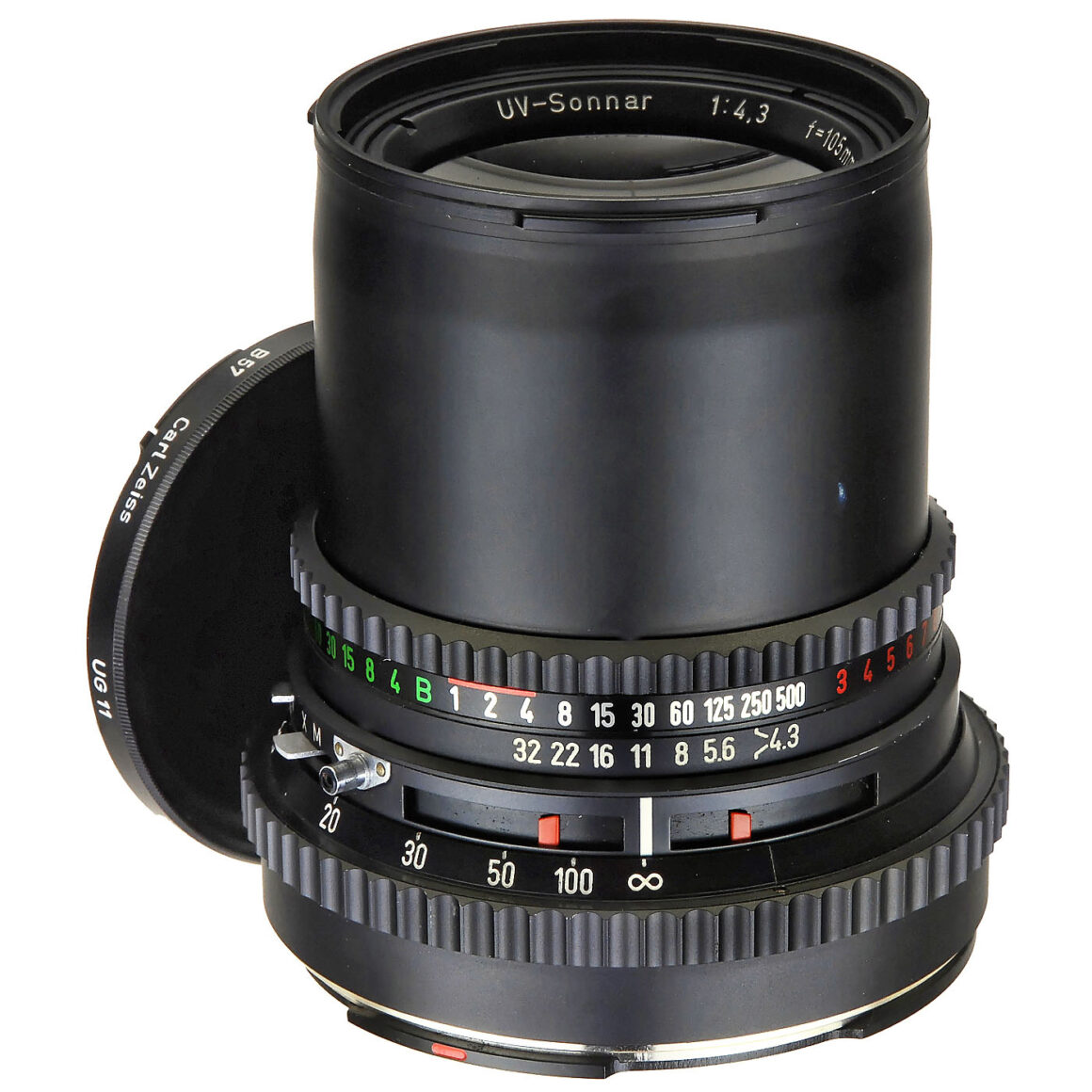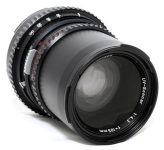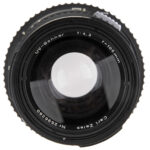Carl Zeiss UV-Sonnar 105mm F/4.3 C
Standard prime lens • Film era • Discontinued • Collectible
- Announced:
- · 1968
- Production type:
- · Small-batch production
- Availability:
- ● Sold out
- Country of design:
- · FRG (Federal Republic of Germany)
- Original name:
- · Carl Zeiss UV-Sonnar 1:4,3 f=105mm
- Class:
- · Slow 6x6 medium-format standard prime lens
- · Professional model (Top class)
- System:
- · Hasselblad V (1957)
Abbreviations
| C | A lens with Compur shutter. |
Model history (2)
| ■Carl Zeiss UV-Sonnar 105mm F/4.3 C | A | 7 - 7 | 1.80m | B50 | 1968 ● | |
| ■Carl Zeiss UV-Sonnar 105mm F/4.3 CF | A | 7 - 7 | 1.80m | B60 | 1982 ● | |
Specification
| Optical design: | |
| Medium format 6x6 | |
| 105mm | |
| F/4.3 | |
| 7 elements in 7 groups | |
| Hasselblad V [74.9mm] | |
| 41.1° | |
| Diaphragm mechanism: | |
Diaphragm type: | Automatic |
Aperture control: | Aperture ring (Manual settings only) |
| Built-in leaf shutter: | |
Type: | Mechanical Synchro-Compur |
Range of shutter speeds: | 1 - 1/500 + B |
Self-timer (V): | Yes |
Shutter speed control: | Shutter speed ring |
Cross-coupling control: | Catch for disengaging cross-coupling |
Flash sync mode: | M & X sync |
Flash sync terminal: | Yes |
| Focusing: | |
| 1.80m | |
| <No data> | |
Focusing modes: | Manual focus only |
Manual focus control: | Focusing ring |
| Physical characteristics: | |
| 670g | |
| ⌀78×87mm | |
| Accessories: | |
| Bayonet-type 50 | |
| Ø50/100-250 40126 - Bayonet-type square | |
| <No data> |
Sources of data
- Manufacturer's technical data.
- Hasselblad 500EL/M, SWC/M, 2000FC, 500C/M booklet (December 1980).
- Hasselblad Product Catalog (November 1977).
- Hasselblad 500EL/M, SWC, 2000FC, 500C/M booklet (December 1977).
- Hasselblad Product Catalog (December 1978).
- Hasselblad Product Catalog (December 1979).
- Hasselblad Product Catalog 1983/84 (December 1982).
- Hasselblad Product Catalog (December 1968).
Manufacturer description #1
The UV-Sonnar f/4.3-105 mm is a special lens consisting of fluorite and quartz lens elements with excellent light transmission in the UV spectral range and chromatic correction in the UV as well as the visible spectral range. The lens thus lends itself to photography in the UV as well as in the visible ranges.
Over the wide range from far UV up to the visible spectral range, the UV-Sonnar features high performance and excellent distortion correction. For UV photographs, focusing can be made with visible light without any further adjustment.
The lens finds wide application in applied technical-cum-scientific photography including studies of textiles, printing forgeries, and materials of all kinds. It is of special interest for extraterrestrial UV photography.
Manufacturer description #2
The 105mm UV-Sonnar is a special purpose lens for technical and scientific photography. This lens features especially good transmission characteristics in the ultraviolet (UV) spectral range. It is highly corrected for all aberrations in the range from short wave ultraviolet to near infrared, i.e. from 215-700 nm.
Lens elements in the UV-Sonnar are made solely of fluorite and quartz, since optical glass absorbs UV radiation.
The UV-Sonnar has outstanding resolving power and distortion correction throughout its wide spectral range. Correction for chromatic aberrations is genuinely apochromatic. In other words, the lens focal length is identical across the visible spectrum and the UV at 3 different wavelengths. The secondary spectrum, i.e. the residual deviations from the common focus for the remaining wavelengths are completely negligible. That is why the lens can be focused for UV work in visible light in the ordinary manner. Selected portions of the spectrum can be utilized for special purposes with the aid of various interference filters. The UV-Sonnar, fitted with a haze filter, can also be used like a normal lens. UV fogging of black & white film and colour film (a blue tinge) is then avoided. The UV-Sonnar makes it possible to solve many complicated problems in UV research. For example, different textiles and sub- stances display varying reflection or transmission of UV light and visible light. Textiles, forged paintings, counterfeit stamps and ancient manuscripts covered by other text, etc. can all be examined with the aid of the UV-Sonnar.
Extra-terrestrial ultraviolet photography and criminology are other important applications for this lens.
Carl Zeiss C series
The first generation of Carl Zeiss lenses with a built-in leaf shutter, introduced in 1957.
- Synchro-Compur leaf shutter with self-timer (V);
- Fully synchronized for M- and X-settings so that you can work with flash at all shutter speeds;
- Aperture and shutter speed are cross-coupled by default but can be set independently for complete creative control;
- Originally matt-chromed, all C lenses were supplied in black trim from 1969 to 1981;
- T* multi-coated from 1973 (30-80mm focal length range), 1974 (all focal lengths).
Frequently asked questions
What does the Carl Zeiss lens designation "Sonnar" mean?
The Sonnar design with relatively few glass to air surfaces is ideal for compact high-performance medium telephoto lenses. It allows apertures up to f/2.8, very elaborate correction of lens errors and even illumination of the image field. In the extreme case of the Sonnar Superachromat CFi 250 mm, sophisticated optical glass types are being used for achieving the extraordinary correction of chromatic aberration and even corner-to-corner illumination. / Source: Hasselblad literature /
Other standard prime lenses in the Hasselblad V system
| ■Hasselblad V mount (1) | |||||||||
| Carl Zeiss UV-Sonnar 105mm F/4.3 CF | A | 7 - 7 | 1.80m | B60 | 1982 ● | ||||








